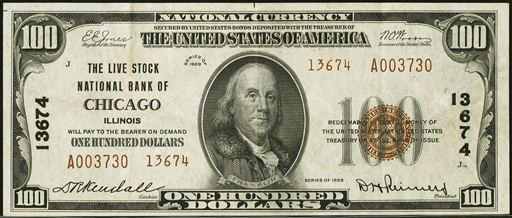The First National Bank Of Parsons
The First National Bank Of Parsons in Kansas printed $833,520 dollars worth of national currency. That is a high amount, but condition and serial numbers can make otherwise common currency from this bank quite valuable. This national bank opened in 1872 and stopped printing money in 1935, which equals a 64 year printing period. That is considering a long operation period for a national bank. During its life, The First National Bank Of Parsons issued 14 different types and denominations of national currency. We have examples of the types listed below. Your bank note should look similar. Just the bank name will be different. For the record, The First National Bank Of Parsons was located in Labette County. It was assigned charter number 1951.
We buy all national currency. Please call or email us for a quote. Sales@AntiqueMoney.com
The First National Bank Of Parsons in Kansas issued 1,000 sheets of $1 original series national bank notes. A print range between 1,000 and 2,500 is small. Combine that with something that was printed before 1875 and you can imagine that these notes are few and far between. One of the most interesting things about early first charter one dollar national bank notes is all of the different slight variations you can find. Some notes have a red charter number, others do not. Some have red serial numbers and some have blue serial numbers. Some are printed on white paper and others are printed on paper with a slight blue tint. You can really find lots of different ways to collect these. Generally speaking, prices for “first charter aces” are down from their highs. So there are some bargains in this arena of collecting.
Original Series $1 National Bank Note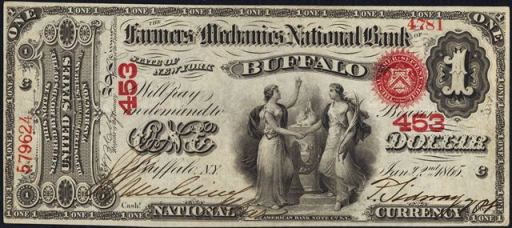
The First National Bank Of Parsons printed 2,950 sheets of $2 original series national bank notes. It is important to know production numbers for original series two dollar bills for informational purposes. All $2 bills printed before 1875 are very rare and highly desirable. Most survivors represent the only known example for that bank. Collectors call these $2 bills lazy deuces. The large two on the face of the bill is pictured horizontally, thus making it look lazy. Don’t be fooled by the silly name though. These can be worth significant amounts of money on many occasions.
Original Series $2 National Bank Note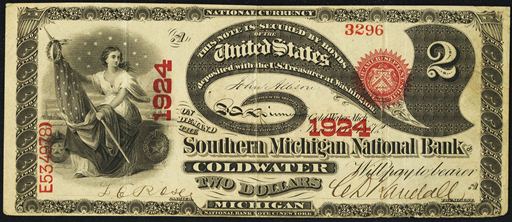
The First National Bank Of Parsons also printed 2,950 sheets of $5 original series national bank notes. It is actually pretty standard for an early national bank to have a sheet output range between 2,500 and 5,000. The exact value of a bill is still going to be based on the number of notes known and the condition of each bank note. Each five dollar original series bank note has a spiked red seal. That is pretty much the only design difference between it and later issues. These are really beautiful notes. One neat thing about these is that the back of each note has a vignette of the corresponding state seal. Some of the state seals are very imaginative. Collecting by state seal was very popular early on in the hobby. Today most collectors are more concerned about bank of issue and condition. Serial number one bank notes are also extremely popular.
Original Series $5 National Bank Note
The First National Bank Of Parsons also printed 520 sheets of $1 series of 1875 national bank notes. It is rare to see a sheet output of under 1,000 like this. However, it did happen for some very scarce issuers. Series of 1875 one dollar first charter national bank notes were only printed between 1875 and 1878. That is the shortest production period of any national bank note. That doesn’t automatically mean that these are worth thousands of dollars, but they could be. Collectors often don’t differentiate between original series and 1875 notes because they look so similar.
Series of 1875 $1 National Bank Note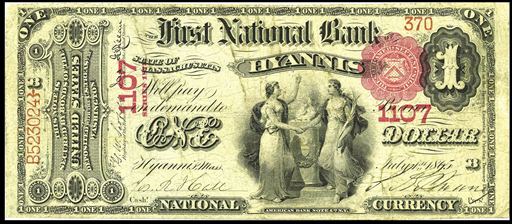
The First National Bank Of Parsons also printed 520 sheets of $2 series of 1875 national bank notes. If you are lucky enough to have a two dollar note from 1875 then don’t get too hung up on the number of bills printed. All notes are rare and in demand; we would be happy to help you value yours. There was only one $2 bill printed per sheet of national currency. So that sheet number also equals the total number of bank notes printed for the denomination. And as we said above, these were also only printed until 1878. That is one of the main reasons they are so rare today.
Series of 1875 $2 National Bank Note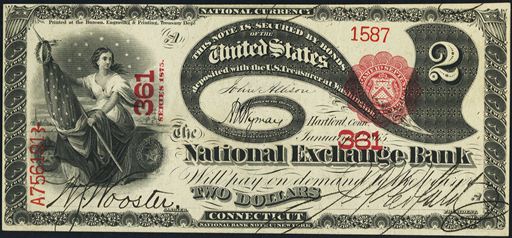
The First National Bank Of Parsons also printed 6,076 sheets of $5 series of 1875 national bank notes. A print range between 5,000 and 10,000 is a pretty high number. But you have to remember we are talking about bank notes from the 1870s and 1880s. Even banks with high issue numbers could be rare today. Series of 1875 $5 bills are some of the most commonly encountered bank notes from the first charter series. Only the original series $1 bill is more available. Some banks exclusively issued five dollar bills. So if you want an example from one of those banks then you don’t have many options. These notes have a rounded red seal and red serial numbers. They also all have a red charter number.
Series of 1875 $5 National Bank Note
The First National Bank Of Parsons also printed 4,650 sheets of $10 1882 brown back national bank notes. That it is not an exceptionally low number of sheets. However, you have to remember that we are talking about bank notes printed before 1902. Even a large print number could have a very low survival rate. There were three $10 bills printed on a single sheet of 1882 brown backs. The design of the bill is similar to all earlier ten dollar national bank notes. The nickname comes from the fact that these bills have a brown seal and brown overprint. Despite saying series of 1882, these were actually printed by some banks up until 1908. The date you see in cursive relates to when the bank first started issuing brown back notes.
Series of 1882 $10 Brown Back
The First National Bank Of Parsons also printed 4,650 sheets of $20 1882 brown back national bank notes. As you can see, the sheet output is the same for $20 brown backs as it is for $10 brown backs. There was only one $20 brown back printed on a sheet. So the sheet output also equals the total note output. One neat thing about all brown backs is that they each have a different back design based on which state issued them. The back left hand side of the note shows the state seal of which ever state the national bank was located in. Generally speaking, 1882 $20 brown backs are pretty difficult to locate. They typically were printed in small numbers and they don’t have a great survival rate.
Series of 1882 $20 Brown Back
The First National Bank Of Parsons also printed 1,454 sheets of $10 1882 blue seal national bank notes. 1882 blue seals are traditionally not the most popular national bank notes. However, when we are talking about such a low print number, these become much more desirable. All of these notes say series of 1882 but they were actually printed between 1908 and 1921. So they aren’t quite as old as the dates might suggest. There is also a date on these notes that is between 1888 and 1901. That date is written in cursive text and it represents when the bank was chartered or re-chartered. Some of the so called 1882 value back notes have a chance to be really rare. Most of the earlier notes that say 1882-1908 on the back are likely going to be relatively common. The designs are exactly the same on the front. Each has a blue seal and charter number.
1882 Blue Seal $10 National Bank Note
The First National Bank Of Parsons also printed 1,454 sheets of $20 1882 blue seal national bank notes. That is the same number of sheets as the ten dollar denomination. You don’t have to multiply by three to get the exact number of notes issued though. There was only one twenty dollar bill per sheet. As with any national bank note, the exact value is still based on the condition, serial number, and bank of issue.
1882 Blue Seal $20 National Bank Note
The First National Bank Of Parsons also printed 1,068 sheets of $50 1902 blue seal national bank notes. There is no trick to knowing which 1902 blue seals will be common and rare. Often times the number printed won’t tell you much information. The value still comes down to condition and demand. That is a surprise to most people. In fact, most 1902 $50 bills we see are worth between $750 and $1,250. The rarer ones can be worth more than $5,000. However, there isn’t much middle ground.
1902 $50 Blue Seal National Bank Note
The First National Bank Of Parsons also printed 1,068 sheets of $100 1902 blue seal national bank notes. It is no coincidence that the sheet numbers for $50 bills and $100 bills are the same. They were printed on the same sheets. Most $100 blue seals are at least scarce; others can be very rare. John J Knox is printed on the front of each bill. Most collectors like the back design a lot more though. It is really unique and different from most other national bank notes. Prices for 1902 $100 blue seals are pretty similar to $50 blue seals. They are both equally common or equally rare, depending on how you look at it.
1902 $100 Blue Seal National Bank Note
The First National Bank Of Parsons also printed 180 individual notes from the type2 1929 $50 national bank note series. Type2 1929 national bank notes are already rare to begin with. A printing of less than 1,000 is especially low. Type2 fifty dollar national bank notes were only printed between 1933 and 1935. Obviously, that is a very short production window. Only 51 national banks in the country printed this type of bank note.
Series of 1929 Type2 $50 National Bank Note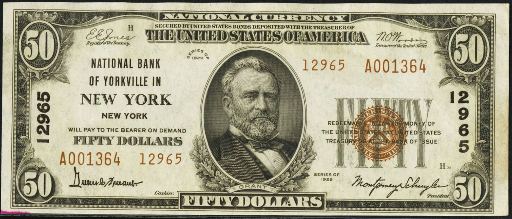
The First National Bank Of Parsons also printed 32 individual notes from the type2 1929 $100 national bank note series. Type2 1929 national bank notes are already rare to begin with. A printing of less than 1,000 is especially low. Surprisingly, only 38 different national banks issued type2 $100 bills. Over 300 are known to exist from all banks in the country, so it isn’t exactly a traditional rarity, but it does have good stats. Just like every $100 bill printed since 1928, these notes also feature a portrait of Benjamin Franklin.
Series of 1929 Type2 $100 National Bank Note